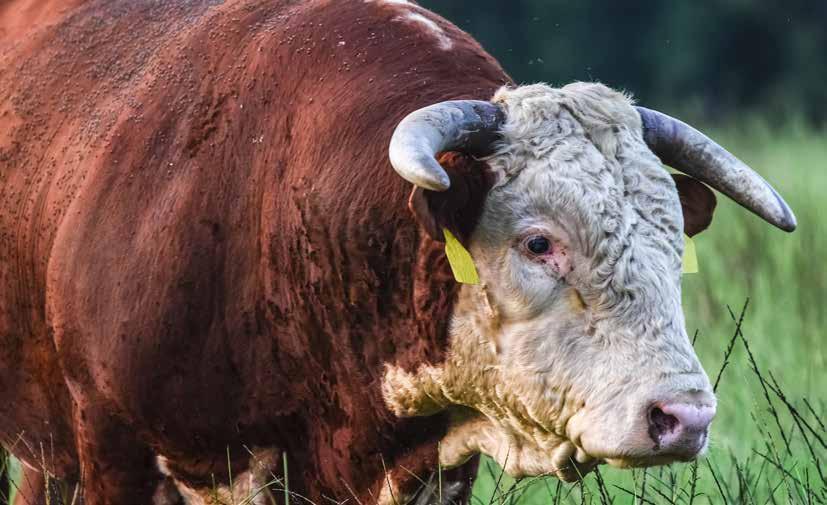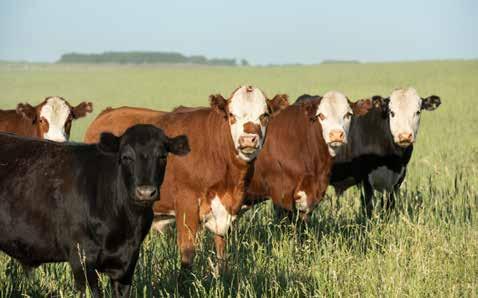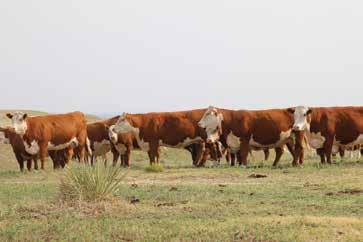
11 minute read
Hereford EPD breakdown
UNDERSTANDING HEREFORD EPDS
Helping simplify bull selection decisions based on data
Advertisement
Reprinted with permission of Hereford World and the American Hereford Association
The American Hereford Association (AHA) currently produces expected progeny differences (EPDs) for 17 traits and calculates three profit indexes.AHA’s genetic evaluation makes use of a Marker Effects Model that allows the calculation of EPDs by incorporating the pedigree, phenotypic and genomic profile of an animal. Animals that have a genomic profile will be denoted with a GE-EPD logo.
The current suite of Hereford EPDs and profit indexes includes:
Calving Ease — Direct (CE) CE EPD is based on calving ease scores and birth weights and is measured on a percentage. CE EPD indicates the influence of the sire on calving ease in females calving at 2 years of age. For example, if sire A has a CE EPD of 6 and sire B has a CE EPD of -2, then you would expect on average, if comparably mated, sire A’s calves would have an 8 percent more likely chance of unassisted calving when compared to sire B’s calves.
Birth Weight (BW) BW EPD is an indicator trait for calving ease and is measured in pounds. For example, if sire A has a BW EPD of 3.6 and sire B has a BW EPD of 0.6, then you would expect on average, if comparably mated, sire A’s calves would come 3 lb. heavier at birth when compared to sire B’s calves. Larger BW EPDs usually, but not always, indicate more calving difficulty. The figure in parentheses found after each EPD is an accuracy value or reliability of the EPD.
Weaning Weight (WW) WW EPD is an estimate of pre-weaning growth that is measured in pounds. For example, if sire A has a WW EPD of 60 and sire B has a WW EPD of 40, then you would expect on average if comparably mated, sire A’s calves would weigh 20 pounds heavier at weaning when compared to sire B’s calves.
Yearling Weight (YW) YW EPD is an estimate of post-weaning growth that is measured in pounds. For example, if sire A has a YW EPD of 100 and sire B has a YW EPD of 70, then you would expect on average if comparably mated, sire A’s calves would weigh 30 pounds heavier at a year of age when compared to sire B’s calves.
Dry Matter Intake (DMI) The DMI EPD predicts the daily consumption of pounds of feed. For example, if sire A has a DMI EPD of 1.1 and sire B has a DMI EPD of 0.1, you would expect sire B’s progeny, if comparably mated, to consume on average 1 pound of feed less per day.
Scrotal Circumference (SC) Measured in centimeters and adjusted to 365 days of age, SC EPD is the best estimate of fertility. It is related to the bull’s own semen quantity and quality, and is also associated with age at pubertyof sons and daughters. Larger SC EPDs suggest younger age at puberty. Yearling sons of a sire with a 0.7 SC EPD should have yearling scrotal circumference measurements that average 0.7 centimeters (cm) larger than progeny by a bull with an EPD of 0.0 cm.
Sustained Cow Fertility The AHA’s new SCF EPD is a prediction of a cow’s ability to continue to calve from three years of age through 12 years of age, given she calved as a two-year-old. The EPD is expressed as a deviation in the proportion of the 10 possible calvings to 12 years old expressed as a probability. For example, the daughters of a bull with a 30 EPD would have the
genetic potential to have one more calf by age 12 than the daughters from a bull with a 20 EPD. In other words, the daughters from the 30 EPD bull would have a 10 percent greater probability of having one more calf than the bull with a 20 EPD. This is equivalent to saying that the daughters are 10 percent more likely to remain in the herd to age 12.
Maternal Milk (MM) The MM EPD of a sire’s daughters is expressed in pounds of calf weaned. It predicts the difference in average weaning weights of sires’ daughters’ progeny due to milking ability. Daughters of the sire with a +14 MM EPD should produce progeny with 205-day weights averaging 24 pounds more (as a result of greater milk production) than daughters of a bull with a MM EPD of -10 pounds (14 minus -10.0 = 24 pounds). This difference in weaning weight is due to total milk production during the entire lactation.
Maternal Milk & Growth (M&G) The M&G EPD reflects what the sire is expected to transmit to his daughters for a combination of growth genetics through weaning and genetics for milking ability. It is an estimate of the daughter’s progeny weaning weight. A bull with a 29-pound M&G EPD should sire daughters with progeny weaning weights averaging 19 pounds heavier than progeny of a bull’s daughters with a M&G EPD of 10 pounds (29 minus 10 = 19 pounds). It is equal to one-half the sire’s weaning weight EPD, plus all of his MM EPD. No accuracy is associated with this since it is simply a mathematical combination of two other EPDs. It is sometimes referred to as “total maternal” or “combined maternal.”
Maternal Calving Ease (MCE) MCE EPD predicts how easily a sire’s daughters will calve at two years of age and is measured on a percentage. For example, if sire A has a MCE EPD of 7 and sire B has a CE EPD of -3, then you would expect on average if comparably mated, sire A’s daughters would calve with a 10 percent more likely chance of being unassisted when compared to sire B’s daughters.
Mature Cow Weight (MCW) The MCW EPD was designed to help breeders select sires that will either increase or decrease mature size of cows in the herd. The trait was developed after years of cow weight data collection and the EPD relates directly to the maintenance requirements of a cow herd. For example, if sire A has a MCW EPD of 100 and sire B has an EPD of 85, then you would expect the females of sire A, if comparably mated, to be 15 pounds heavier at mature size.
Udder suspension (UDDR) UDDR EPDs are reported on a 9 (very tight) to 1 (very pendulous) scoring scale. Differences in sire EPDs predict the difference expected in the sires’ daughters’ udder characteristics when managed in the same environment.
For example, if sire A has a UDDR EPD of 0.4, and sire B has a UDDR EPD of -0.1, the difference in the values is 0.5, or one-half of a score. If daughters of sires A and B are raised and managed in the same environment, you would expect half a score better udder suspension in daughters of sire A, compared to sire B.
Teat size (TEAT) TEAT EPDs are reported on a 9 (very small) to 1 (very large, balloon shaped) scoring scale. Differences in sire EPDs predict the difference expected in the sires’ daughters’ udder characteristics when managed in the same environment. For example, if sire A has a teat size EPD of 0.4, and sire B has a teat size EPD of -0.1, the difference in the values is 0.5, or one-half of a score. If daughters of sires A and B are raised and managed in the same environment, you would expect half a score smaller teat size in daughters of sire A, compared to sire B.
Carcass Weight (CW) CW EPD is a beneficial trait when considering the impact that pounds have relative to end product value. At the same age constant endpoint, sires with higher values for carcass weight will add more pounds of hot carcass weight compared to sires with lower values for carcass weight. For example, if sire A has a CW EPD of 84 and sire B has a CW EPD 64, then you would expect the progeny of sire A, if harvested at the same age constant endpoint, to have a 20-pound advantage in terms of hot carcass weight. Rib Fat (FAT) The FAT EPD reflects differences in adjusted 365day, 12th-rib fat thickness based on carcass measurements of harvested cattle. Sires with low, or negative FAT EPDs, are expected to produce leaner progeny than sires with higher EPDs. Ultrasound measures are also incorporated into this trait and have been shown to be highly correlated with the performance of slaughter progeny. All data is expressed on a carcass scale. ...CONTINUED ON PAGE 42

...CONTINUED FROM PAGE 41
Ribeye Area (REA) REA EPDs reflect differences in an adjusted 365-day ribeye area measurement based on carcass measurements of harvested cattle. Sires with relatively higher REA EPDs are expected to produce better- muscled and higher percentage yielding slaughter progeny than will sires with lower REA EPDs. Ultrasound measurements are also incorporated into this trait and have been shown to be highly correlated with the performance of slaughter progeny. All data is expressed on a carcass scale.
Marbling (MARB) MARB EPDs reflect differences in an adjusted 365-day marbling score (intramuscular fat, [IMF]) based on carcass measurements of harvested cattle. Breeding cattle with higher MARB EPDs should produce slaughter progeny with a higher degree of IMF and therefore higher quality grades. Ultrasound measurements are also incorporated into this trait and have been shown to be highly correlated with the performance of slaughter progeny. All data is expressed on a carcass scale.
Baldy Maternal Index (BMI$) The BMI$ is a maternally focused index that is based on a production system that uses Hereford x Angus cross cows. Progeny of these cows are directed towards Certified Hereford Beef. This index has significant weight on Sustained Cow Fertility, which predicts fertility and longevity of females. There is a slightly positive weight on Weaning Weight, Mature Cow Weight and Milk which accounts for enough growth but ensures females do not increase inputs. There is some negative emphasis on Dry Matter Intake, but a positive weighting on Carcass Weight which is anticipated to provide profitability from finishing of non-replacement females and castrated males. Marbling and Rib-eye Area are also positively weighted to keep the harvested progeny successful for CHB. This index is geared to identify Hereford bulls that will be profitable when used in a rotational cross with mature commercial Angus cows.
Brahman Influence Index (BII$) The BII$ is a maternally focused index that is based on a production system that uses Brahman x Hereford cross cows. Progeny of these cows are directed towards a commodity beef market since Certified Hereford Beef© does not accept Brahman influenced cattle. This index has significant weight on Sustained Cow Fertility, which predicts fertility and longevity of females. There is a slightly positive weight on Weaning Weight, Mature Cow Weight and Milk which accounts for enough growth but ensures females do not increase inputs.
There is some negative emphasis on Dry Matter Intake, but a positive weighting on Carcass Weight which is anticipated to provide profitability in finishing nonreplacement females and castrated males. Marbling and Rib-eye Area are also positively weighted to keep harvested progeny successful for a variety of commodity based programs. This index targets producers that use Hereford bulls on Brahman influenced cows.

Western Region #1 Field Staff

COVERING ••• Wash. Ore. Idaho Calif. Nev. Utah Ariz.

Clint Brightwell
41020 Pocahontas Rd. Baker City, OR 97814 • 417-359-6893
cbrightwell@hereford.org
Certified Hereford Beef Index (CHB$) CHB$ is a terminal sire index that is built on a production system where Hereford bulls are mated to mature commercial Angus cows and all progeny will be targeted for Certified Hereford Beef© after the finishing phase. This index has significant weight on Carcass Weight to ensure profit on the rail. As well there is a positive weighting for Average Daily Gain along with a negative weighting on Dry Matter Intake to ensure efficient pounds of growth in the finishing phase. Keep in mind, this production system takes advantage of complimentary breeding with the commercial Angus cow. Although Marbling is weighted positively in this index, a positive weighting for Ribeye Area and a negative weighting for Back Fat are a greater priority in this index to allow for optimum end-product merit. This is the only index that has no emphasis on fertility. Remember that no replacement heifers are being retained.

T HE U TAH H EREFORD A SSOCIATION

BULL SALE

30 B ULLS • 15 F EMALES

M ARCH 6 • 1 PM • P RODUCER ’ S L IVESTOCK • S ALINA , UT Selling 45 Head from these Progressive Hereford Breeders



PHIL ALLEN AND SON, ANTIMONY • DICK JONES, ORANGEVILLE • COURTNEY LAW, CORNISH OLIVER BROTHERS, LEVAN • RON AND DERRICK REED, LAS VEGAS • 4 TAYLORS LIVESTOCK, NEOLA



NJW 73S W18 HOMETOWN 10Y ET SIRED BY THESE BREED-LEADING BULLS!
Boyd 31Z Blueprint 6153 NJW 73S M326 TRUST 100W ET Whitehawk Warrior 845C
Come enjoy a great afternoon hosted by the Utah Hereford Association! Call Shannon Allen at 435-624-3285












